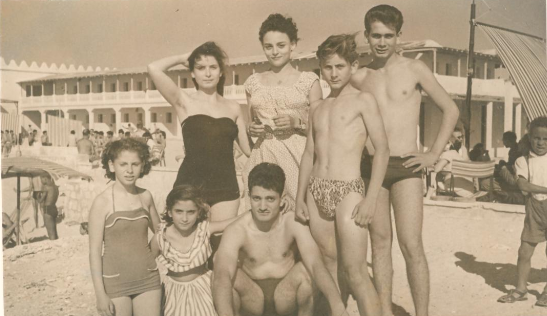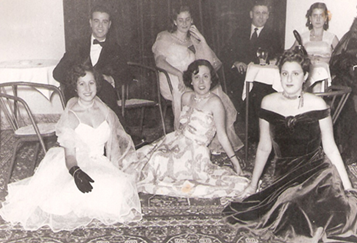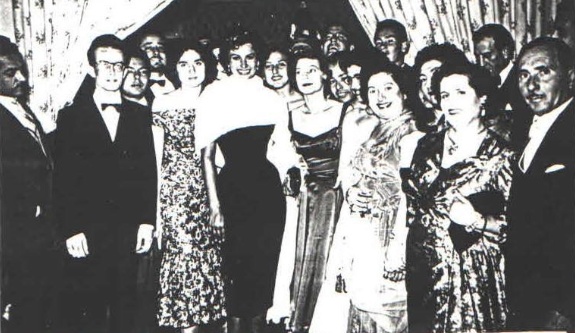Between Sophia Loren and 'Little Tony': The Leisure Life of the Jews of
Tripoli, Libya in the Fifties and Sixties
By Eyal David*
"On June 5, when the first news of the Six Day War reached Tripoli, the riots broke out (...) Tripoli, the clean and pleasant city has become something out of Dante's Inferno. The air was heavy, smoky, police and soldiers armed with rifles and submachine guns were everywhere. The streets were littered with broken glass, broken objects, broken wood and looted goods from shops (...) it was clear that the rioters were going first to the Jews, but now they are after everything foreign....”
This quote, taken from a testimony of a bank teller, reveals the
'discordant final note' in the life of the small and wealthy Jewish
community that remained in Tripoli in the fifties and the sixties - its
elimination in 1967 following the Six Day War. The war exposed Jews to
violent riots in which 17 people were murdered, including two entire
families that were killed by a Libyan officer: the Luzon family and the
Baranes-Raccah family, the family of my grandfather's sister. This
pogrom was the third in two decades (previous pogroms occurred in 1945
and 1948), and came after years of political and economic restrictions
that narrowed the activity of Jews in the economic and commercial life
of the city. The Jewish community, which was for generations an integral
part of the social fabric of the country, had to hide and quickly leave
the country, their homes, and all their possessions. A small number of
Jews did remain in the country until the 1969 military coup of Muammar
al-Qaddafi, who, through a series of measures and rules immediately
clarified that in the 'new Libya' under his rule there was no place for
foreigners and Jews.
The small Jewish community that remained in Libya after the great wave
of emigration to Israel from 1949 to 1951 was concentrated mainly in the
capital of Tripoli (a few remained in the city of Benghazi), numbered
over 4,000, and according to some reports was one of the wealthiest
Jewish communities in the world at the time. These Jews were mainly
members of the upper middle class who chose to remain in the country
under the independent Libyan regime of King Idris (starting December
1951) and did not have their bags packed in anticipation of an
opportunity to leave, as one would think. On the contrary, they were
integrated into a narrow stratum of foreign and Muslim elites, all of
whom roamed in the same social milieu and were rooted in Tripoli by
their property, assets, and financial interests.
The lives of the Jews in the city were marked by constant contradiction
and it seems that they, whether consciously or unconsciously, ‘walked on
eggshells’. On the one hand, they were locals; some of them came from
families with old roots in the country that continued to play a vital
and stable role in the domestic economic scene even after the discovery
of oil in the country in the late fifties and the resulting foreign
investment. But on the other hand, with their behavior and dress, they
made it clear that they were not Arabs. Like the other foreign members
of the elite, they saw the center of their identity in Europe,
especially in Italy, and thus neither in Africa nor in the Arab world.
Some of them even held European nationalities, mainly Italian but also
French and British for example. Therefore, they adopted Western cultural
trappings and symbols of social status, which separated them from the
surrounding Muslim society. Although they lived in an independent Muslim
country, most of the time they conducted their lives in Italian and not
in Arabic. In addition, they maintained their Jewish identity albeit
with a high degree of religious flexibility, even when their Judaism
brought discriminatory laws against them. And in general, they kept
their distance from the Muslim population, which constituted the
majority of Libya. For these Muslims, the Jews, in their clear
identification with the Italian culture and language, turned their backs
on the Libyan Arab society. Moreover, their high socioeconomic status
completely contradicted the low status they should have had historically
as ‘ahl al-dhimma’ (a protected religious minority under Muslim rule).
Further, anti-Jewish propaganda on the radio and in newspapers as well
as in sermons in mosques, which intensified in view of the prolonged
Arab-Israeli conflict, increased hostility against Jews.
Despite the restrictions, prohibitions, and harassment that the Jews
faced at that time and the natural sense of fear that some of them felt,
they continued to live a comfortable and vibrant life, which was
characteristic of the narrow bourgeois social stratum in Tripoli. From
interviews I conducted with members of the community in Israel and
Italy, as well as the little written documentation that exists on the
subject, it was revealed that the places of entertainment and leisure
were their escape points, in some ways ‘islands of sanity’ in a social
reality that was changing from moment to moment against them.
Furthermore, these places gave them a stable anchor to hold on to,
albeit illusory and fleeting.
The community spent its leisure time at the beach of Tripoli, or the 'Lido' as it is called in Italian,in house parties, coffee shops and modern cinemas that screened mostly Italian but also French and Hollywood movies. Besides these, you could find the upper middle class Jews of Tripoli in the exclusive clubs of the Italians and the British in the city. One of the most prominent clubs was The Italian Club (Il Circolo Italia), which was located in front of the impressive and beautiful promenade, Il Lungomare, which was built near the beach during Italian rule. It was a prestigious member-only club that offered its patrons a variety of activities in the fields of sports and entertainment, including sport teams like basketball and boxing, various classes in areas like theater and ballet, and Bridge tournaments. The club, as its name indicates, was designated for the Italian community in the city, but among its members were also some wealthy Jews including a few members of the community I interviewed. They stressed that Muslims did not frequent the club at all, only Christians and Jews, but not only those holding Italian nationality. They said they had sent their children to the classes held at the club and that they visited the club when there were concerts and shows in Italian and for the Christmas and the New Year celebrations (Capodanno in Italian). One of the interviewees talked about how "when it was Christmas, rich Jews were taking up the tables and the Italians were upset: 'What is going on, this is our celebration and the Jews are taking all the places?!’."

Summer at the 'Lido' of Tripoli, the fifties
(Courtesy of Vito Raccah)

Jewish women in Western dress, evening event at the Italian club
(Courtesy of my grandmother Laura Baranes)
The Hotels located on the promenade were other centers in which parties and celebrations were held. The most glamorous one was the Uaddan hotel, which was established in 1935 and was described as the "jewel of modern African architecture". Daily cocktail parties were conducted at the hotel and it had a fancy entertainment hall where different balls were held, such as the New Year's Eve ball, Saturday night parties that "gave a good reason to hang out until after midnight", costume parties, and festive events as varied as weddings of the rich, including Jews. The Uaddan hosted famous artists from Italy in the field of music, theater and cinema, such as Sophia Loren, Little Tony, Peppino di Capri, Rita Pavone and many others and the rich echelon did not miss their performances. It also had a large swimming pool and it was the home of the only casino in town. The nightly entertainment in the casino was favored by more than a few Jews who visited it on weekdays as well as on Saturdays and holidays, and often lost a lot of money.

Dinner held in honor of Sophia Loren (center) in the Uaddan hotel, March 1957
(Courtesy of Vittorio Halfon)
Another recreational pursuit that should be mentioned is that of brothels and nightclubs. The interviewees mentioned names of two major nightclubs - the more prominent was the Mokambo and the other was a nightclub that operated in Suq al-Mushir (سوق المشير), one of the markets within the old city. These clubs held "deluxe" cabarets, as one interviewee described them, as it was "something with class, not something dirty," and the people who came there were "people who had some money, also Arabs." They hosted dance performances and stripteases of "beautiful girls, but not Arabs. They were all foreign, European. Most of them from Italy, but there were also Yugoslavian, German, English, Spanish, French... ."
In conclusion, most of the Jews who remained in Libya after the great wave of immigration of 1949-1951 continued to live their lives, while enjoying many comforts but struggling to maintain their fractured identity as the social space where it existed slowly diminished. This continued until the living conditions became intolerable and they were forced to leave. At once, they had to abandon the rich and full life they had had and start from scratch, as immigrants in a new country. Only about a half of the community that had moved to Italy in the late 1960s, mainly the adults, immigrated to Israel later. A few from the last wave immigration and the former ones reached other countries such as the USA, France, and England.
* Eyal David received his MA from the department of Middle Eastern Studies at the Hebrew University of Jerusalem. His thesis The Daily Life of Upper-Middle Class Jews in Tripoli, Libya: 1951-1967 was written under the guidance of Professor Harvey Goldberg and Doctor Liat Kozma, both from the Hebrew University. Contact: eyalda1@gmail.com.
This is a translation of the article published in Hebrew on the Social History Workshop of "Ha'Aretz" website on 18.11.2015: http://www.haaretz.co.il/blogs/sadna/1.2779905.
